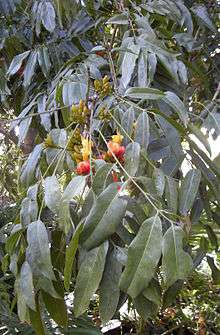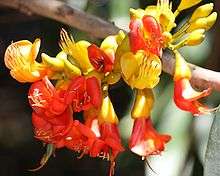Castanospermum
Castanospermum australe (Moreton Bay chestnut or blackbean), the only species in the genus Castanospermum,[2][3] is a flowering plant in the family Fabaceae, native to the east coast of Australia in Queensland and New South Wales, and to the Pacific islands of Vanuatu, New Caledonia, and the island of New Britain (Papua New Guinea).[4]
| Castanospermum | |
|---|---|
 | |
| C. australe | |
| Scientific classification | |
| Kingdom: | |
| (unranked): | |
| (unranked): | |
| (unranked): | |
| Order: | |
| Family: | |
| Subfamily: | |
| Tribe: | |
| Genus: | Castanospermum A.Cunn ex Hook. |
| Species: | C. australe |
| Binomial name | |
| Castanospermum australe A.Cunn & C.Fraser ex Hook. | |
Growth
It is a large evergreen tree growing to 40 metres (130 ft) tall, though commonly much smaller.[5] The leaves are 15 centimetres (5.9 in) long and 6–7 centimetres (2.4–2.8 in) broad, pinnate, with 11-15 leaflets. The flowers are bicoloured red and yellow, 3–4 centimetres (1.2–1.6 in) long, produced in racemes 6 centimetres (2.4 in) long. The fruit is a cylindrical pod 12–20 centimetres (4.7–7.9 in) long and 4–6 centimetres (1.6–2.4 in) diameter, the interior divided by a spongy substance into one to five cells, each of which contains a large chestnut-like seed.
Common names
The 1889 book 'The Useful Native Plants of Australia' records the common names of Castanospermum australe as "Moreton Bay Chestnut" and "Bean tree" and notes that it was called "Irtalie" by Aboriginal people of the Richmond and Clarence Rivers (New South Wales) and "Bogum" by "others of Northern New South Wales".[6] Other names that have been used by Aboriginal peoples are: baway,[7] yiwurra,[7] junggurraa,[7] mirrayn,[7] ganyjuu,[7] and binyjaalga.[8]
Uses
Chemicals
In 1981, castanospermine was isolated from the seeds.[9] Members of this genus accumulate iminosugars in their leaves.[10]
Cultural significance
Due to its importance as a food, the blackbean tree was a seasonal gathering point for Aboriginal peoples, and this acted as a catalyst for ceremonies.[11] Songlines featuring the black bean seeds have been collected.[12] The bark fibre has been used for fish and animal traps, nets and baskets, and the empty seed pods have been used as toy boats.[12] Additionally, the tree has been used as a seasonal signal for when to hunt jungle fowl.[12]
Food
The seeds are poisonous, and can cause vomiting and diarrhoea,[13] but become edible when carefully prepared by roasting, cutting up into small pieces, leaching with running water for several days, and pounding into flour and roasting it as a damper.[14] The seeds have been prepared and eaten for at least 2,500 years.[15] The 1889 book 'The Useful Native Plants of Australia' notes and describes this use of the beans.[16] As of 2012, the food was not used in modern bush tucker, and there was no nutritional information available on the seeds.[5]
Spread
Due to its significance as a food for Aboriginal people, blackbean trees were spread by hand into mountain areas on the east coast of Australia. All the trees in New South Wales are descended from a single seed.[11] The plant naturally spreads by water.[12] It has been introduced to India, Malaysia, Papua New Guinea, Sri Lanka, South Africa and the United States of America.[5]
 Castanospermum australe flower
Castanospermum australe flower- Small C. australe tree
 Mature pod and seeds
Mature pod and seeds
References
- Cardoso D, Pennington RT, de Queiroz LP, Boatwright JS, Van Wyk BE, Wojciechowski MF, Lavin M (2013). "Reconstructing the deep-branching relationships of the papilionoid legumes". S Afr J Bot. 89: 58–75. doi:10.1016/j.sajb.2013.05.001.
- "ILDIS LegumeWeb entry for Castanospermum". International Legume Database & Information Service. Cardiff School of Computer Science & Informatics. Retrieved 30 January 2014.
- USDA; ARS; National Genetic Resources Program. "GRIN species records of Castanospermum". Germplasm Resources Information Network—(GRIN) [Online Database]. Beltsville, Maryland: National Germplasm Resources Laboratory. Archived from the original on 2015-09-24. Retrieved 30 January 2014.
- Debevec, Mojca (2002). "Castanospermum australe - Growing Native Plants". www.anbg.gov.au. Australian National Botanic Gardens, Parks Australia.
- Lim, T.K. (1 January 2012). "Castanospermum australe". Edible Medicinal And Non-Medicinal Plants. 2. Springer Netherlands. pp. 593–600. doi:10.1007/978-94-007-1764-0_73. ISBN 978-94-007-1763-3.
- J. H. Maiden (1889). The useful native plants of Australia : Including Tasmania. Turner and Henderson, Sydney. p. 396.
- "Seed words in local language" (PDF). Wet Tropics Management Authority. Retrieved 28 February 2018.
- "Gumbaygnggirr Language Names" (PDF). National Parks and Wildlife Service. Retrieved 28 February 2018.
- Hohenschutz, Liza D.; Bell, E.Arthur; Jewess, Phillip J.; Leworthy, David P.; Pryce, Robert J.; Arnold, Edward; Clardy, Jon (January 1981). "Castanospermine, A 1,6,7,8-tetrahydroxyoctahydroindolizine alkaloid, from seeds of Castanospermum australe". Phytochemistry. 20 (4): 811–814. doi:10.1016/0031-9422(81)85181-3.
- Kite GC, Cardoso D, Lewis GP, Zartman CE, de Queiroz LP, Veitch NC (2015). "Monomethyl ethers of 4,5-dihydroxypipecolic acid from Petaladenium urceoliferum: Enigmatic chemistry of an enigmatic legume". Phytochemistry. 116: 198–202. doi:10.1016/j.phytochem.2015.02.026. PMID 25817832.
- Miskelly, Greg (13 November 2017). "Aboriginal people spread native plants by hand: study". ABC News. Retrieved 13 November 2017.
- Rossetto, Maurizio; Ens, Emilie J.; Honings, Thijs; Wilson, Peter D.; Yap, Jia-Yee S.; Costello, Oliver; Round, Erich R.; Bowern, Claire; Borges, Renee M. (8 November 2017). "From Songlines to genomes: Prehistoric assisted migration of a rain forest tree by Australian Aboriginal people". PLOS ONE. 12 (11): e0186663. doi:10.1371/journal.pone.0186663. PMC 5695580. PMID 29117184.
- "Australia's most poisonous plants - Australian Geographic". Australian Geographic. 2012-07-04. Retrieved 14 November 2017.
- Ancient Aboriginal process for cooking black beans. Royal Botanic Gardens. 12 November 2017. Retrieved 14 November 2017.
- "Black bean". Royal Botanic Gardens. Retrieved 14 November 2017.
- J. H. Maiden (1889). The useful native plants of Australia : Including Tasmania. Turner and Henderson, Sydney. p. 15.
- Jack, Helen (30 May 2007). "Bentley man says money does grow on trees". The Northern Star. Retrieved 13 November 2017.
-

- "Black bean". www.daf.qld.gov.au. Archived from the original on 13 November 2017. Retrieved 13 November 2017.
External links


- Bush Tucker Plants: Moreton Bay Chestnut
- "Castanospermum australe - A.Cunn.&C.Fraser. ex Hook". www.pfaf.org. Plants for a Future.
- How to eat Black bean on YouTube